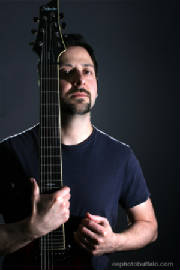By: Joe Pinnavaia
 Let’s say that most of us don’t have three hours a day to practice (I’m sure I would much rather be doing that than most anything else!). There are times when there’s just not enough time to devote to physical practice. In this series of articles I will discuss different ways of musical practice that don’t have to be done at home or in a studio.
Let’s say that most of us don’t have three hours a day to practice (I’m sure I would much rather be doing that than most anything else!). There are times when there’s just not enough time to devote to physical practice. In this series of articles I will discuss different ways of musical practice that don’t have to be done at home or in a studio.
Practicing aural skills is one of the most overlooked skills by guitar players.
Unfortunately guitarists mostly think and play with their hands, and not always what they hear in their head. I know I’ve been guilty of this guitar sin as well. Once you start working on aural skills you should notice a change in your playing and improvising almost immediately. Even your phrasing will become more natural and more musical. This can make the difference between someone who sounds like a pro and someone who sounds like an amateur.
When I was attending the University of Buffalo, I did take an aural skills class that covered scales, rhythm and sight singing exercises. Oh the horror I felt while in that class because it really opened my eyes to how much I couldn’t connect the sounds in my head to the outside world. I couldn’t stand not being able to sing a major scale, although I could easily play it on my guitar in all positions!
So, the first thing to work on would be singing the scales as you play them on the guitar, internalizing how the distance between each pitch sounds. This will help identify intervals and interval relationships down the road.
Also, work with those intervals; prime, minor second, major second, minor third, major third, perfect fourth, augmented fourth, flat fifth, perfect fifth, flat sixth, major sixth, minor seventh, major seventh and octave, and be able to differentiate between them aurally.
There are several websites that deal with intervals and identifying tonalities of chords one is www.eartrainer.de, which is free to register and because it’s online you can work on pitch identification from anywhere.
The next item to work on is rhythm. Gary Chaffee’s book Rhythm and Meter Patterns would be a great place to start since it is well written and relatively inexpensive. Tapping out the rhythms will jump start your brain into dividing beats into groups of notes, which can make even the most difficult rhythm seem easy.
This book also comes with a CD that you could listen to in the car. Think of how much time you spend driving in a car each week. For me it’s about 200 minutes, it’s about time you start putting that time to good use.
Another useful strategy – and one that is easy to do in the car – is the use of backing tracks. Backing tracks are sold in numerous places and come in all styles of music. Pick whatever style suits you and start vocalizing ideas over the tracks.
You don’t have to worry about getting all of the notes right off the bat, instead, focus more on phrasing and breathing, just like a wind player has to do. When you start thinking in this way you’ll find that your lines will take on different shapes and contours that you wouldn’t normally play.
Also, that your phrases will become more musical, because you HAVE to breath. Most guitarists don’t breathe when they play, which causes all types of rhythm and phrasing issues. So, once you go back to the guitar after implementing some of these ideas on your own, you should start hearing a difference in your phrasing right away.
One last thing to keep in mind is, when doing these exercises imagine the tone that you want, and even picture how some of your favorite players would sound like. Use that as a guide if you get stuck along the way.
Next time we will discuss how visualization can make an impact on your practicing.

Tweets that mention Ear Training Exercises for Guitarists | Guitar International Magazine -- Topsy.com (13 years ago)
[…] This post was mentioned on Twitter by Matthew Warnock and Guitar International, The Lone Guitarist. The Lone Guitarist said: RT @GtrIntlmag Ear Training Exercises for Guitarists http://bit.ly/bSu5kd […]
Rolle (13 years ago)
Thanks for this great article! I wish I had better ears… :) Another great lesson is from Justin: http://www.youtube.com/watch?v=fMwFA8HJhlM (transcribing and using your ear)
Simon Harris (13 years ago)
Very pleased to see you mention sight singing. Too many guitarists test themselves on intervals. Whilst the best way to develop a sensed for the different degrees of the major scale and the spaces between them (ie. the intervals is to learn to sing them!
Publisher (13 years ago)
We agree, sight singing is an often overlooked tool that guitarists can use to train their ears!